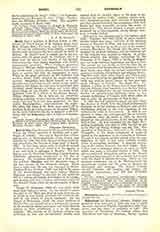

Bois-le-Duc, the Diocese of (BUSCODUCENSIS) lies within the Dutch province of Brabant, and is suffragan of Utrecht. The city of Bois-le-Duc (s’Hertogenbosch, or Hertzogenbusch—Sylva Ducis) was founded in 1184, but, with the surrounding territory, was included in the Diocese of Liege until March 12, 1561. At that time, and in order to check the spread of Protestantism, Pius IV raised it to the dignity of a see, and made it suffragan to Mechlin. The first bishop was the illustrious theologian Francis Sonnius (1562-69), afterwards transferred to the See of Antwerp. His successors suffered not a little amid the political disorders and the disastrous wars of the last quarter of the sixteenth century. When after a long siege the city was captured by Prince Frederic Henry (September 14, 1629) and held in the name of the States-General, the sixth bishop, Michael Ophorius, was obliged to abandon his see, which he did in a solemn procession, surrounded by his clergy, and bearing with him a famous miraculous statue of the Blessed Virgin which he placed in safety at Brussels.
Joseph de Bergaigne (1638-47) was really little more than bishop in name. He was unable to assert his right to the office, and lived an exile from the see to which he was deeply attached, but which he beheld in the power of Dutch Calvinists. By the Treaty of Westphalia (1648) the entire territory of Bois-le-Duc was recognized as a permanent conquest of the seventeen united provinces, and made directly subject to their jurisdiction, i.e. to the States-General. The exercise of the Catholic religion was forbidden by law, and the pertinent decrees were applied with all possible rigour in the hope of extirpating the ancient Faith. Catholic priests, however, continued secretly their ministry of preaching and their administration of the sacraments, while their flocks met with invincible patience the storm of persecution. The diocese became a simple mission, governed by a vicar-Apostolic, nearly always, however, a titular bishop.
Bois-le-Duc was administered in this fashion until 1853. Napoleon had tried (1810) to create another diocese under that name, inclusive of the territory known as Bouches du Rhin, and had even obtained a titular for the new see in the person of the imperial courtier, Monsignor Van Camp, but the latter was despised by all good Catholics, and the arbitrary act of the emperor was doomed to failure. A similar failure awaited the attempt, authorized by the Concordat of August 27, 1827, to divide all Holland into two large dioceses, Amsterdam and Bois-le-Duc. The ancient see was finally revived by Pius IX on the occasion of the restoration of the hierarchy in Holland, where, since 1848, the revised constitution has assured to Catholics full political and religious liberty. Together with three other Dutch sees, Bois-le-Duc was reestablished by the pontifical Brief of March 4, 1853, and with its former limits; all four sees were made suffragan to Utrecht. The Right Rev. Jan Zwysen, a native of the diocese and its most illustrious son, hitherto vicar-Apostolic, was the first bishop of the reestablished see, though temporarily he was known as administrator-Apostolic, since he was already Archbishop of Utrecht, with which office he was to unite the government of Bois-le-Duc.
In 1865 the first provincial synod was held there, the decrees of which form the actual ecclesiastical discipline in all the dioceses of Holland, and exhibit Archbishop Zwysen as the true organizer of the ecclesiastical order in that country. In 1868 he was allowed to resign the archiepiscopal See of Utrecht. Thenceforth, until his death in 1877, he devoted himself to the administration of his beloved See of Bois-le-Duc. He was succeeded by the Right Rev. Adrian Godschalk, who died in 1892, leaving the see to be filled by Bishop William van den Ven. The cathedral of Bois-le-Duc, dedicated to St. John the Evangelist, is the finest monument of medieval Gothic in the possession of the Catholics of Holland. Though it was almost entirely rebuilt after the conflagration of 1419, it had again suffered notable decay in succeeding centuries. A thorough restoration of the edifice, however, was later begun. Bois-le-Duc had a collegiate chapter as early as 1360, which was made a cathedral chapter in 1561. The above-mentioned miraculous statue of the Blessed Virgin has been restored to the cathedral and is once more the object of general devotion. There are two diocesan seminaries, one at St. Michiels-Gestel for preparatory studies and the other at Haaren for philosophy and theology. The diocese includes 451,670 Catholics, 260 parishes, 625 priests, 143 charitable institutions, and 476 free (Catholic) schools.
GISBERT BROM

